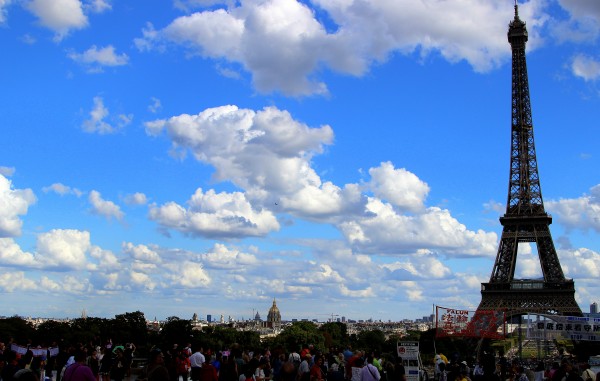 Like the pyramids of Egypt and the Colosseum of Rome, the Eiffel Tower is one of those immediately recognizable landmarks. I remember the first time I was driven into Paris (we were actually stuck in the mind-blowing congestion of the 5 p.m. rush hour on the Peripherique road that circles the city) when I looked up and realized I was finally looking at the actual tower. Such a thrill.
Like the pyramids of Egypt and the Colosseum of Rome, the Eiffel Tower is one of those immediately recognizable landmarks. I remember the first time I was driven into Paris (we were actually stuck in the mind-blowing congestion of the 5 p.m. rush hour on the Peripherique road that circles the city) when I looked up and realized I was finally looking at the actual tower. Such a thrill.
Since then I’ve visited the tower in sun, rain, early in the morning and at night and I never fail to get a charge out of it. It would be nicer without all those other people — and the ubiquitous signs warning of pickpockets are a bit of a downer — but it is still a lot of fun. Winter is always better than summer, although you will need to keep an eye on the weather, conditions can lead to restrictions on where you can go.
The tower was built as the archway to the 1889 World’s Fair. You probably know it’s named after engineer Gustav Eiffel, whose company designed and built the tower. But you may not be aware that it was quite controversial. A number of people, including the writer Guy de Maupassant, a protege of Flaubert’s, hated the idea of plonking a huge metal oil derrick in the middle of elegant Paris.
Eiffel, in typical modest, retiring engineer fashion, blandly compared the tower to the pyramids and the project steamed ahead. The plan was to take the tower down in 20 years but Eiffel came up with the idea of encouraging using it for scientific experiments, including radio communications, and it survived. At 1,050 feet tall (somewhere near the equivalent of an 80-story building) the tower ought to be completely out of place. And yet, with its soaring arches and elegant narrow lines, it is quite beautiful, whether viewed up close or from a distance.
If you would like to visit the structure, go here for more information. You can take the elevator to the top, which costs €15 (about $20) or take the stairs to the 1st or 2nd floor for €5. (Note: 1st floor France = 2nd floor America. The official “3rd floor” is at the top.) Elevators run from the North, East and West pillars, going to the 2nd floor where you switch for the elevator to the very top. South is stairs only. Check the website before visiting for info to scope out weather conditions, possible elevator outages, and approximate wait times.
If you are reasonably hale and hearty you may want to consider taking the stairs to the 1st and/or 2nd floors and then catching the elevator to the top if you want to go higher. The lines are shorter for the stairs, sometimes much shorter, tickets are cheaper, and the climb is not too arduous at about 700 stairs with places to rest. The stairs between the 2nd floor and the top are closed to the public so if you want to go higher it’s time to jump in the ascenseur. There are exhibits on the 1st floor, panoramic views from the 2nd and more view at the top as well as Eiffel’s office complete with the gramophone Edison gave him.
There’s an app available for smart phones with a guided tour of the tower. If heights make you peckish, you can pick up a snack at the 1st floor buffet, eat at the brasserie on that floor, book a table at the very expensive Jules Verne restaurant on the 2nd floor or sip on bubbles at the Champagne Bar on the 3rd floor at the top.
The tower can also be enjoyed from the ground — be sure to walk up the steps of the nearby Palais de Chaillot, which offers good views of the tower and the skyline.
You’ll probably walk away a fan of the tower. Unlike de Maupassant. His dislike of the structure never abated. In fact, he is said to have routinely eaten lunch at one of the tower’s restaurants, remarking tartly that that was the one place in the city he could be sure of not having a view of the structure.
- Ticket info: http://www.tour-eiffel.fr/en/preparing-your-visit/planning-your-visit.html
- Don’t miss: Seeing the tower at night. Crowds drop a bit, the tower is lit up like a Christmas tree and the views of the city glowing beneath the night sky are magnificent.
